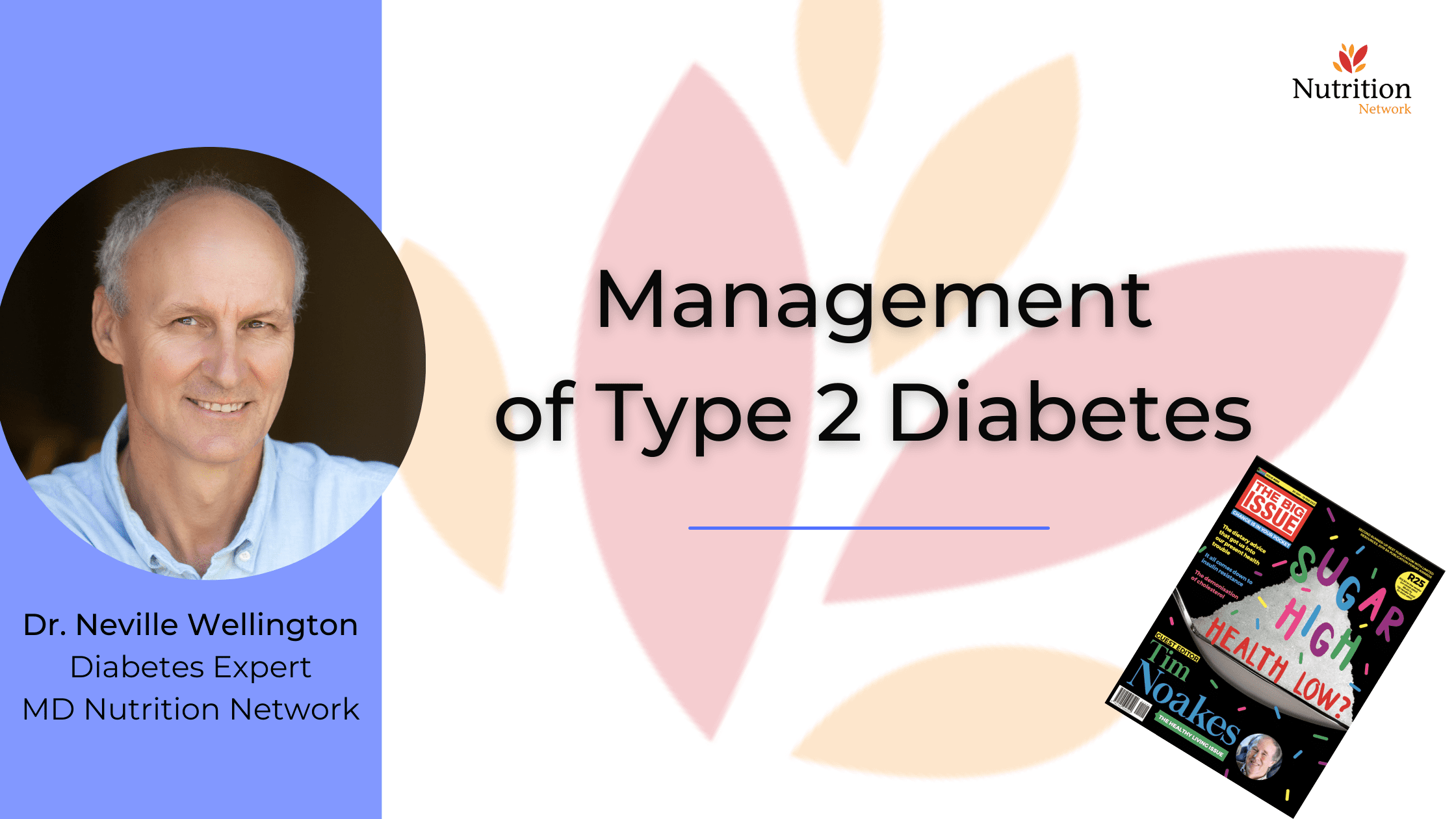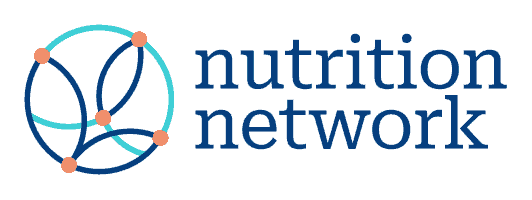
By Dr Neville Wellington – Diabetes expert, Medical Director Nutrition Network, Board of Directors The Noakes Foundation
Introduction
Type 2 diabetes is the type that affects more than 90% of patients who have diabetes. Prof Noakes mentioned the work of Dr George Campbell in the 1960’s who assessed the diets of the Zulu and Indian patients who attended his clinic at The King Edward VIII Hospital in KwazuluNatal.(1) He found that the intake of sugar was approximately 40 kg per year in the urban population. He also noted that “The peak ‘incubation period’ in 80 such diabetics lay between 18 and 22 years”, which led him to develop “the ‘rule of 20 years’”. He was able to corroborate this with many other researchers around the world. In other words, he showed that a high sugar/carbohydrate intake for 20 years was linked to type 2 diabetes onset in susceptible people. Of interest is that South Africans are still consuming about 34-36 kg of sugar per year per person according to the US department of agriculture. The recent 2019 IDF statistics on diabetes prevalence show that 12.8% of South Africans have diabetes.
Since the 1960’S when it seemed apparent that the intake of sugar was the principal cause of diabetes, science has confirmed the mechanisms by which diabetes is caused by sugar.(2-7) In short, a high intake of sugar, which digests to glucose and fructose, is then metabolised in the liver. The sugar is converted into fat and is deposited in the liver ultimately causing a fatty liver. Under normal circumstances the liver also manufactures glucose for the body’s energy needs, and this process is controlled by insulin (released by the pancreas). However, when someone has a fatty, damaged liver, it tends to become unresponsive to the effects of insulin, and glucose levels rise. The pancreas then has to produce more insulin to control the liver glucose production, and so more and more insulin is produced. This state is called insulin resistance, as the liver becomes resistant to the effects of insulin. This is worsened by the high intake of glucose in our diets, and as insulin also stimulates the production of fat, and prevents fat breaking down, it causes the body to store excessive fat and so weight is gained.
So when it comes to treating diabetes, our goal is to lower the excessive intake of sugars and carbohydrates, which allows the liver to ‘heal’, lowers the excessive production of insulin, and facilitates weight loss. For the rest of this article I will describe how we go about this in treating diabetes.
Carbohydrates
Carbohydrates are the group of foods we eat which release the monosaccharides glucose, fructose and galactose (referred to as “sugar” in the accompanying infographic). Carbohydrates usually contain one or two of them in combination. For instance sucrose (table sugar) contains equal components of glucose and fructose, while milk contains lactose which is a combination of glucose and galactose. For the sake of diabetes treatment, all carbohydrates that are eaten release these ‘sugars’, which can cause blood glucose levels to spike. While most patients with diabetes will cut out sugar, they still continue to eat carbohydrates which can release just as much glucose. What I now know from treating patients is that the more they reduce their carbohydrate intake the less their glucose or ‘blood sugar’ levels spike. We measure the amounts of carbohydrates in grams, and what research has shown is that if the total amount of carbohydrates eaten per day is < 30g (i.e. 7 tsp) diabetes can be very well controlled or even reversed.
So the first thing is to know how much carbohydrates are in various foods. Here is a list with approximate values.
Common Carbohydrates and approximate values
1 tsp sugar =4-5g of carbohydrates
1 slice bread ≈ 15g
1 plate cereal ≈ 23-30g
250ml Fizzy sugared drink = 28g
200ml fruit juice = 28-32g
250ml apple juice = 24-32g
100g spaghetti = 70g
1x100g potato/sweet potato = 21g
1 cup cooked rice = 20g
1 medium apple =18g
1 large banana = 28g
100ml sweetened yoghurt = 15g
250ml sweetened yoghurt =37.5g
100g slab chocolate 62g
Nutrition labels can also help one identify how many carbohydrates in the food. Always check for the total glycaemic carbohydrates to see how much you are eating. Ideally, patients should avoid all sugars, sweets, confectionaries, breads, cereals and low fat foods. Low fat foods tend to be fortified by sugars to make them palatable. Avoid all processed foods which generally mean foods that come in a box. While whole foods like fruit and vegetables contain micronutrients that your body can use, it is advisable to cut them down or avoid if it means exceeding your daily target of carbohydrates. Rather seek out foods that come still in their natural forms as in this list: (also look at the Green, Orange and Red lists provided by TNF)
Eggs
Full fat meats
Chicken with the skin
Fish
Leafy green vegetables
Avocados
Olive oil
Coconut and coconut oil
Fatty nuts like almonds and macadamia nuts
Cheese
Full cream milk
Butter
Monitoring Glucose levels
While reducing your carbohydrate is important, the only way to know whether your glucose levels are reducing is to monitor them in a structured way. For this, patients need glucometers, which can be easily purchased at any pharmacy. Glucose levels should be checked before and after every meal, especially when you are first diagnosed (or if you are really serious about controlling your diabetes after reading this!) I give patients sheets like these to fill in, and instruct them to check glucose levels before and 60-90 minutes after starting eating.
The more patients monitor, the more they are able to see which foods help to control their glucose levels. I often see dramatic changes in glucose levels as you can see from this patient’s download of his glucometer.
Continuous glucose meters are also able to give excellent information. This patient below made some changes to his diet and one can see the difference.
Medication
It is critical that all this is done under the guidance of a doctor, especially as patients need to be guided as to how to reduce or change their medications. If patients are not careful, they can develop hypoglycaemia (low sugar) spells and this may push them off course. We often find that patients can reduce or even stop their medications.
Conclusion
Type 2 diabetes can be well managed by understanding that carbohydrates raise glucose levels and these should be reduced. Glucose monitoring is essential to empower patients. Patients also need to understand that it may take time to reverse the damage that has been done, but can live in the hope that it is possible to control and even reverse their diabetes and prevent much of the damage and agony that is seen with having diabetes.
References:
- Campbell GD. Diabetes in Asians and Africans in and around Durban. South African medical journal = Suid-Afrikaanse tydskrif vir geneeskunde. 1963;37:1195-208.
- Johnson RJ, Perez-Pozo SE, Sautin YY, Manitius J, Sanchez-Lozada LG, Feig DI, et al. Hypothesis: could excessive fructose intake and uric acid cause type 2 diabetes? Endocrine reviews. 2009;30(1):96-116.
- Iizuka K. The Role of Carbohydrate Response Element Binding Protein in Intestinal and Hepatic Fructose Metabolism. Nutrients. 2017;9(2).
- Le KA, Tappy L. Metabolic effects of fructose. Current opinion in clinical nutrition and metabolic care. 2006;9(4):469-75.
- Vos MB, Lavine JE. Dietary fructose in nonalcoholic fatty liver disease. Hepatology. 2013;57(6):2525-31.
- Sevastianova K, Santos A, Kotronen A, Hakkarainen A, Makkonen J, Silander K, et al. Effect of short-term carbohydrate overfeeding and long-term weight loss on liver fat in overweight humans. The American journal of clinical nutrition. 2012;96(4):727-34.
- Adeva-Andany MM, Perez-Felpete N, Fernandez-Fernandez C, Donapetry-Garcia C, Pazos-Garcia C. Liver glucose metabolism in humans. Bioscience reports. 2016;36(6).
